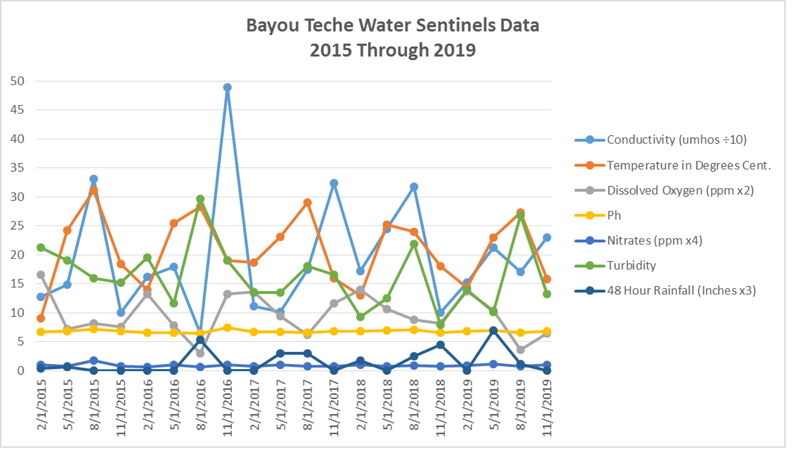Water Quality Monitoring

The two tables below represent almost 10 years of citizen science water quality monitoring on Bayou Teche. We would like to express our appreciation of the volunteers who donated their Saturday mornings once per quarter to take samples.
For the purpose of simplifying these graphic illustrations, the time of month is listed as the first of the month; however, in actuality the testing was conducted on the second Saturday of the month around noon.

What Do The Various Testing Elements Mean?
The points on the graph represent the average values of water sampling on all of the water testing stations, which over time varied from 5 to 9 stations on Bayou Teche from Port Barre to Franklin. Nitrates and PH levels are fairly constant in Bayou Teche. Nitrates are a measure of nutrient loading from agricultural practices, and in Bayou Teche these values are within the range of a healthy watershed system. The Dissolved Oxygen (DO) test is a measure of the oxygen gas that is dissolved in water. It is a direct way of measuring the capacity of natural water to support fish and the organisms they feed on. Natural water holds more dissolved oxygen at lower temperatures. The testing done by our volunteers on Bayou Teche shows this relationship. Note that the results for DO are significantly higher in the samples taken in November and February. When the temperature in degrees centigrade is low, the DO is high. A dissolved oxygen level of 5 parts per million (ppm) is desirable for supporting trout. Catfish can live with lower levels of DO. For purposes of illustration, the test results for DO are multiplied by two so we can better see the relationships between DO and temperature. Turbidity levels typically increase with high water flows. The August 2016 water testing was performed one week after the 2016 flood in Acadiana, and the peak in turbidity is evident in the sampling values. Conductivity is a measure of the water’s capability to pass electrical flow and is directly related to the concentration of conductive ions that come from dissolved salts and inorganic material such as chlorides and sulfides. A delayed peak in conductivity was also indicated in the November 2016 water sampling effort, showing that the 2016 flood increased these conductive ion materials.
Taking The Water Quality Program Into The Future
The citizen-science water testing demonstrated seasonal trends in water quality and showed how major flood events triggered changes in water chemistry. We believe, however, that continuing the current testing program beyond 10 years will not provide significant insight into the real water quality issue that Bayou Teche is experiencing (i.e., fecal coliform contamination). So, on May 9, 2020, the Citizen Science Water Testing Program will cease, and The TECHE Project will shift gears to work with the Teche-Vermilion Fresh Water District to enhance their fecal coliform testing efforts. We will post more information about this effort as this program develops.

